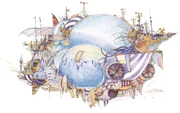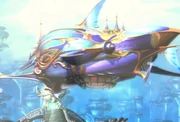I remember a guy with spiky hair who carried something like this.Zidane Tribal after seeing a "Buster Sword"-like object in an equipment shop.
Final Fantasy IX was intended, in many ways, to be a salute to the history of the Final Fantasy series, and as such, it is filled with allusions and references to previous games. One of the most apparent is the similarity of the playable characters to the classic job classes of previous games, most notably Vivi to the Black Mage of the original Final Fantasy.
In the English translation, not all of the various names and references match up to those used in the previous English-language releases, and because of this, many of the references are missed by the non-Japanese audience.
Final Fantasy series
- The normal battle theme's introduction bass line is similar to the first six games. This bass line is not used in the regular battle themes of Final Fantasy VII or Final Fantasy VIII (although the final boss theme "The Extreme" has this bass line at the start of the faster section). Similarly, the victory theme involves the typical melody after the initial fanfare, which is absent from Final Fantasy VII and Final Fantasy VIII.
- The early installments' stories revolved around crystals. The earliest games had the crystals kept in shrines, but in Final Fantasy IV and Final Fantasy V it is the different nations of the world who are entrusted with protecting their respective crystal. These elements are alluded to in Final Fantasy IX with the crystal shards of the eidolon Alexander being divided among the nations of the world and the villains' plan involves attacking other nations to capture their crystals. The elemental shrines also return, but instead of housing the crystals of element they serve another role in the story.
- An allusion to the three titles on the NES, several of the major cities include chapels, which were the foremost method of saving, reviving fallen party members, and healing one's HP and MP.
- Alexandria's chapel is near the western dock, where moogles Kupo, Stiltzkin, and Artemicion make appearances.
- The chapel in Lindblum is located in the Business District and is undergoing maintenance.
- Other locations, such as Gizamaluke's Grotto, Esto Gaza, Conde Petie, and the Cleyra settlement, seem to be religious centers. None house chaplains offering services of game-saving or character revival, but the empty chapel in Alexandria holds the first location in the game where one can use a moogle to save one's game, use a Tent, or begin the Mognet sidequest.
- Furthermore, scattered across all of Gaia are healing springs where the party can replenish their HP and MP at no expense, often occurring as natural or volcanic springs, but none reside within the aforementioned chapels.
- As in the previous PlayStation era Final Fantasy games, Final Fantasy IX has a secret island location in the far corner of the world, not visible on any map. Unlike both Round Island and the Deep Sea Research Center, the game's strongest summon is not obtained in Chocobo's Paradise. Like in Final Fantasy VII, getting a gold chocobo is the means of reaching the island.
- The giant boss creature, Hilgigars, was meant to be Hill Gigas. Gigas is a common name in the series for oversized humanoids, most frequently seen in Final Fantasy and Final Fantasy VII, and seen again as an entire beastmen race in Final Fantasy XI and later in Final Fantasy XII.
Final Fantasy
- Garland shares his name with the main antagonist of the original game.
- Mount Gulug was meant to be Gurgu Volcano, as seen in the original Final Fantasy, having a similar layout and dungeon music. The name is written in Japanese as グルグ, or "Gurugu".
- Princess Cornelia, a character in the I Want to Be Your Canary play, may be named after a location in Final Fantasy.
- The world map of Final Fantasy IX, Gaia itself, is a tribute to the original game's topographic structure. All of the major landmasses are arranged in a manner similar to Final Fantasy, though nations and locales (save for the aforementioned exceptions) vary considerably.
- The Pumice item in Final Fantasy IX, used to learn the summon Ark, the massive, transforming airship, is known as the "Floating Stone" (ふゆう石, Fuyuuishi?). In the original NES version of Final Fantasy, the item was translated as "FLOATER", and was used to lift the ancient airship from the desert.
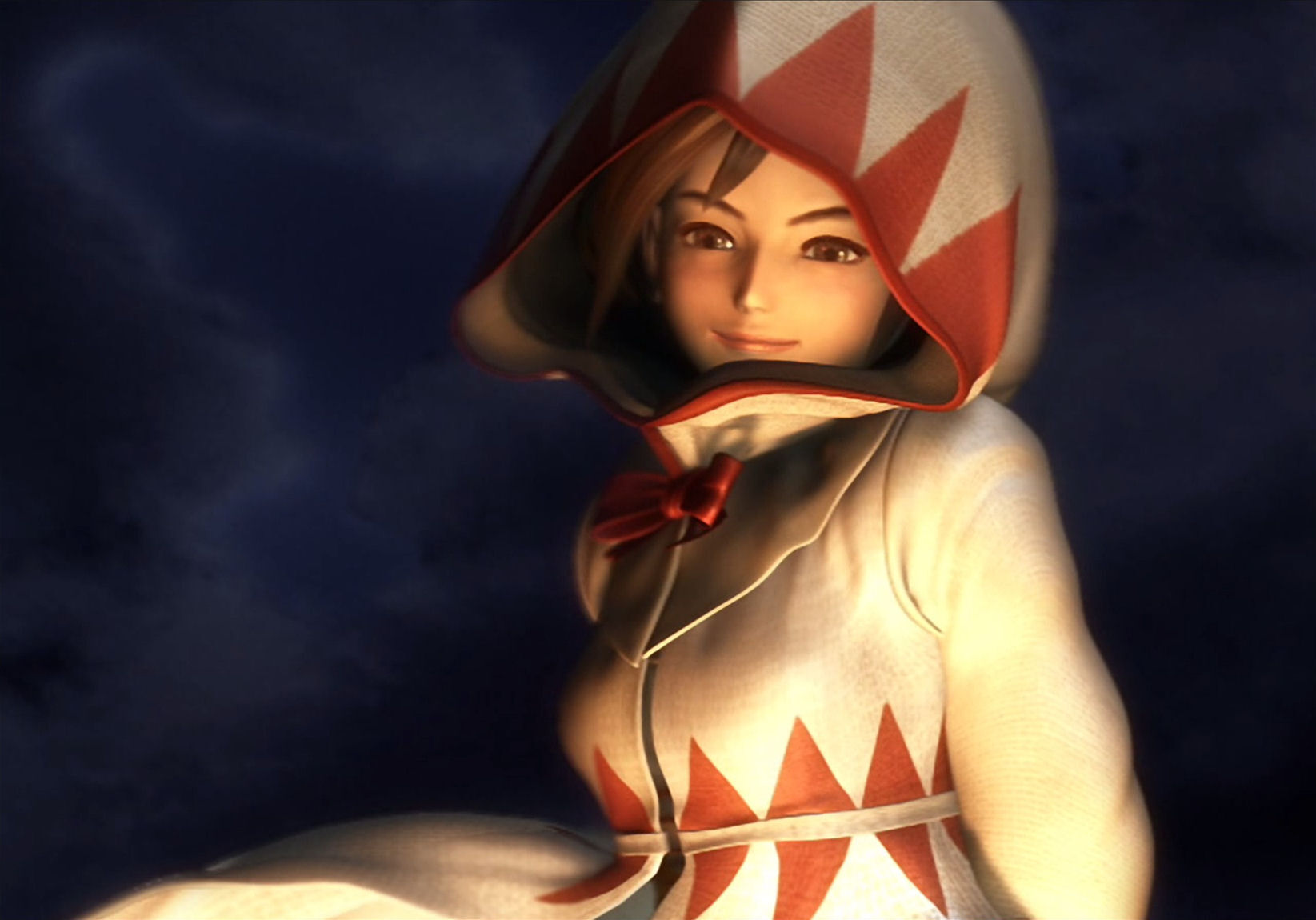
- At the beginning of the game, during her escape, Princess Garnet's robe resembles the traditional White Mage's robe, a job that first appeared in the original Final Fantasy.
- The four elemental fiends that protect the elemental shrines and are later fought in Memoria, known as the guardians of Terra, are Maliris, Tiamat, Kraken, and Lich. The four recall their counterparts in the Final Fantasy, the Four Fiends (in the anglicized version of Final Fantasy, the fiend of fire was called "Kary", although the name "Marilith" was restored in the Final Fantasy Origins version).
- The way the fiends are encountered in Memoria as fixed encounters refers to the way they were encountered in the past's Chaos Shrine in the original Final Fantasy.
- When finding the potions to cure Cid, the items refer to the book of Matoya.
- Jane alludes to Queen Jayne, who was called Queen Jane in some translations. Queen Jayne's daughter is Princess Sarah, and in Final Fantasy IX Jane's daughter is Garnet, whose real name is Sarah, who became a princess after fleeing Madain Sari.
- Alexandria Castle resembles Castle Cornelia.
- The Ice Cavern is possibly a reference to the Cavern of Ice from the original Final Fantasy.
- After escaping the Evil Forest the party takes control of Zidane, Garnet, Vivi, and Steiner, which refers to four of the original classes of the original Final Fantasy: Warrior (Steiner), Thief (Zidane), Black Mage (Vivi) and White Mage (Garnet).
- The layout of the beds in the inn at Dali is done in the same style as the beds in the first three Final Fantasy installments.
Final Fantasy II
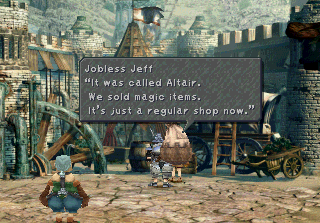
- During the first interlude in South Gate, the shop near the cable car is named Altair, which shares its name with the town the Wild Rose Rebellion fled to at the start of Final Fantasy II.
- The name "Altair" was implemented to juxtapose the item shop in the northern station of South Gate named "Vega", which refers to the Tanabata legend in Chinese-originated Japanese folklore. The stars Orihime (Vega) and Hikoboshi (Altair) are lovers separated by a river of stars (Milky Way). They meet once a year on the seventh day of the seventh month. In Final Fantasy IX, the Aerbs Mountains obstruct the shops and their lovesick owners. The relationship is the subject of the Mognet letter Grimo asks to deliver to Nanza.
- In Gizamaluke's Grotto the bells required to open the doors hearken to the Goddess's Bell from Final Fantasy II used to open Kashuan Keep.
- Pandemonium was the name of Emperor Mateus's castle of Hell. The music that accompanies the Pandemonium of Final Fantasy IX is a remix of its Final Fantasy II counterpart with a slower tempo, played together with notes from Garland's theme.
- During the player's encounter with Ramuh at Pinnacle Rocks, they are required to recite a story to earn his trust. The story describes an incident in Final Fantasy II involving an ice cave and a boulder which prompts one of the characters, Josef, to sacrifice himself to save the others.
- Cid's wife, Hilda, shares her name with the leader of the Fynn resistance in Final Fantasy II.
- In Lindblum, there is a man named Guy. Guy is a playable character in Final Fantasy II.
- The comment viewable in the inventory on the Protection Bell is signed by Philosopher Minu. This refers to Minwu from Final Fantasy II, but lost the connection in translation in the English localization.
- In Treno's card stadium there's a player named Leyra. In the Japanese script, her name is written the same as Leila's, a playable character in Final Fantasy II.
Final Fantasy III

- Zidane's Theme is similar to the music inside the airship. In addition, this theme is first heard during the hijacking of the cargo ship.
- "Une's Mirror" and "Doga's Artifact" bought at the Treno Auction House refer to the characters Unei and Doga. Une's Mirror has the engravement: The body may perish, but the spirit lives on, which were Unei's words in Final Fantasy III. Zemus from Final Fantasy IV also uses this line.
- After obtaining the Invincible airship, the player can return to the Black Mage Village and examine the gramophone in the inn. If the player possesses the Doga's Artifact and Une's Mirror, the background music will change to "Doga and Une's Theme" from Final Fantasy III. The melody continues until the player leaves the village.
- In Mount Gulug there is a note on a bulletin board written by Une the Mole.
- Garland and Kuja's airship of destruction, Invincible, is named after the ultimate airship of Final Fantasy III.
- Before fighting Necron, the party members are revived by the non-fighting members in a way similar to how the Warriors of Light were revived by Doga and Unei.
- There is a thematic parallelism between Kuja/Xande and Necron/the Cloud of Darkness. Both Kuja and Xande fear their mortality, and both unintentionally perform globally-perilous actions that lead both Necron and the Cloud of Darkness to enter into the mortal realm to revert the world to nothingness. Neither Necron nor the Cloud of Darkness show up until the ending and appear as the final boss. The final boss theme accompanying these encounters is structurally similar.
- In the game's Japanese script, Sasune is mentioned as the kingdom Prince Schneider hails from in I Want to Be Your Canary. Sasune is a location in Final Fantasy III.
Final Fantasy IV
- The dwarves of Conde Petie use the same greeting as the dwarves of Final Fantasy IV (ラリホ, rariho?), but the original saying "Lali-ho" was changed to "Rally-ho" in Final Fantasy IX. This change is rationalized further by the localization giving the dwarves Scottish accents, reminiscent of 18th-century Scottish poet Robert Burns.

- Namingway appears as a Tetra Master card. The card allows the player to change the characters' names by showing it to a man in Daguerreo, similar to how Namingway allowed the player to rename characters in the original Final Fantasy IV.
- Cid's last name is "Fabool", a homophone for the kingdom of Fabul in Final Fantasy IV.
- Upon arriving in Lindblum for the first time, if the player searches the area Steiner was just in during the Active Time Event as they leave the inn, they will find a sign towards the northwest part of the area called Polom's Action Figures; a combination of the names of Palom and Porom, the twin mages of Final Fantasy IV.
- The early-game music "Skies of Alexandria" borrows from Final Fantasy IV's "Red Wings" theme as the airship approaches the kingdom.
- One of Freya's ultimate weapons is Kain's Lance, a reference the Dragoon Kain Highwind from Final Fantasy IV. The design of the spear is identical to the one Kain wields in the Final Fantasy IV logo
 .
. - Zorn and Thorn use Twincast, the ability of Palom and Porom. During the battle against them, they give each other the power to cast Flare and Meteorite (Comet).
- Alexander in Final Fantasy IX and the Giant of Babil in Final Fantasy IV are summoned using the same means: the gathering of crystals.
- Yoshitaka Amano's artwork
 of the Giant of Babil and Alexander look remarkably similar.
of the Giant of Babil and Alexander look remarkably similar.
- Yoshitaka Amano's artwork

- In Final Fantasy IV there are two moons, one of which is red. This is similar to the blue world of Gaia and the red one of Terra. In cutscenes, both a red and a blue moon loom in the skies of Gaia. The Final Fantasy IX Ultimania guide calls these the Gaia and Terra moons whose orbital paths cross every 16 days when one becomes closer to the planet than the other.
- Vivi uses the Fire spell to melt ice in Ice Cavern. This is reminiscent of the ice blockade on Mt. Hobs, which Rydia melted with Fire in Final Fantasy IV.
- Cleyra is called "City of Illusions". The title of the music that plays in the Feymarch in Final Fantasy IV is "City of Illusions".
- If the player examines the Une's Mirror in the key items screen, the description is The body may perish but the spirit lives on. This is similar to Zemus's quote The body dies but the spirit lives on in the PlayStation port of Final Fantasy IV.
- In Final Fantasy IV, an Antlion that used to be docile attacks Prince Edward. In Final Fantasy IX, an antlion that was known to be docile attacks a member of royalty, Prince Puck.
- The old man who gives the player the Excalibur in exchange for the Magical Fingertip is Kokuro, the dwarven blacksmith from Final Fantasy IV. The player can find this out by getting the Magical Fingertip and talking to the innkeeper before talking to the old man.
- One of the card players in the Treno Tetra Master tournament is called Gilbert, Edward's Japanese name.
- Many of the airships in Final Fantasy IX resemble the airships from Final Fantasy IV'.
- The Red Rose resembles The Red Wings airships. Both are owned by the first kingdoms/nations revealed to the game (Alexandria and Baron).
- The Hilda Garde I resembles the Lunar Whale.
- The Invincible resembles the artwork by Yoshitaka Amano of the Enterprise airship from Final Fantasy IV.
- Beatrix of Alexandria and Cecil Harvey of Baron share similarities in many ways:
- Both command their country's elite force and are feared by many.
- Both were devoted to their monarch and carried out orders without question, until one point.
- Both are paladins (although Cecil did not start out as one).
- As a general of Alexandria, Beatrix rides the Red Rose, whose design and name resembles the Red Wings, which was under Cecil's command.
- Alexandria resembles Baron in many ways:
- Both are the first nations revealed to the game (and both are kingdoms).
- Both rulers (Brahne and King of Baron), once peaceful (although with different motives) turned power-hungry and became aggressive toward other nations.
- Both rulers adopted orphans (Garnet and Cecil) and treated them as their own. Both adopted children would be their successors.
- Zidane and Kuja's origin and relationship mirrors Cecil and Golbez's.
- In Alexandria, in front of the weapon and synthesis shops, there is a set of statues of three women. One is tall, one is fat, and the other is short. This alludes to the Magus Sisters.
- Final Fantasy IV introduced the concept of flying chocobos that can only land in forests. This is also used in Final Fantasy IX.
- The Second Battle of the Iifa Tree mirrors the Battle of the Giant of Babil. Both are fought between magical foes on one side and two nations (which had been at war with each other earlier) on the other, and both take place when the protagonists do not expect aid.
- Eiko Carol resembles Rydia in many ways. Both were born in a village of summoners who have a traditional lifestyle that revolves around the creatures they summon. Both lose their parents and have their villages destroyed by the game's antagonists. Both join the party at a young age, make an effort to act above their age and are able to use white and summoning magic. Furthermore, the artwork for the Angel Flute shows Eiko grown up, indicating there might've been plans to have her grown during the game, similar to what happens to Rydia.
- The final battle with Necron is similar to Zeromus, the final boss of Final Fantasy IV. Both battles start with the characters weakened but are healed by the characters not chosen for the final battle. Both bosses proclaim that they will always exist after the player defeats them.
Final Fantasy V


- Steiner's Sword Magic ability is taken from Mystic Knights from Final Fantasy V.
- The moogle theme from Final Fantasy V is remixed for the background music at Mognet Central.
- Boko, Bartz's chocobo companion from Final Fantasy V, has a Tetra Master card whose image resembles his original sprite. Furthermore, two black mages in the Black Mage Village hatch a young chocobo they name Bobby Corwen; the first syllable of Bobby and the first syllable of Corwen allude to the name.
- Another Tetra Master card of an airship has an image that resembles its Final Fantasy V sprite.
- Freya's Lancer ability first appeared in Final Fantasy V.
- In Final Fantasy V, Softs could be used to instantly kill enemies made of stone. This also works in Final Fantasy IX.
- Gilgamesh, a minor antagonist in Final Fantasy V, appears as a four-armed man in Alexandria, Treno, and later in Daguerreo.
- Tantarian, the book monster in Alexandria, resembles a Page 64. A Page 256 is featured on the cover, a Page 32 is seen on the spine, while the back cover contains a Page 128. All are "book monsters" found inside the Library of the Ancients in Final Fantasy V.
- Necron's ultimate attack is Grand Cross. Exdeath also uses this attack in Final Fantasy V.
- Atomos, the eidolon, is from Final Fantasy V. During the battle against him in Final Fantasy V, Atomos sucks the party towards him, reflecting the eidolon's attack in Final Fantasy IX of sucking everything into its mouth in the zone it is attacking.
- Nova Dragon is a translation of Shinryu, the superboss from Final Fantasy V.
- Famed Mimic Gogo's name crops up in Daguerreo when an old blacksmith seeks out the Magical Fingertip item. Gogo is said to be a master craftsman who made dolls that look like real people, and the secret is supposedly his fingertips.
- The platform for the battle against Deathguise and Trance Kuja is identical to the one for the last boss encounter in Final Fantasy V.
- If the player obtains the Excalibur II sword, they get a message from Gilgamesh's brother Enkido, mentioning he has taken the Excalipur and left Excalibur II for Gilgamesh. Excalipoor first appeared in Final Fantasy V and was the weapon Gilgamesh mistook for the legendary sword Excalibur.
- One of the players in the Treno card stadium is called Thalisa. This refers to Sarisa Scherwil Tycoon, but lost the connection in translation in the English localization.
Final Fantasy VI
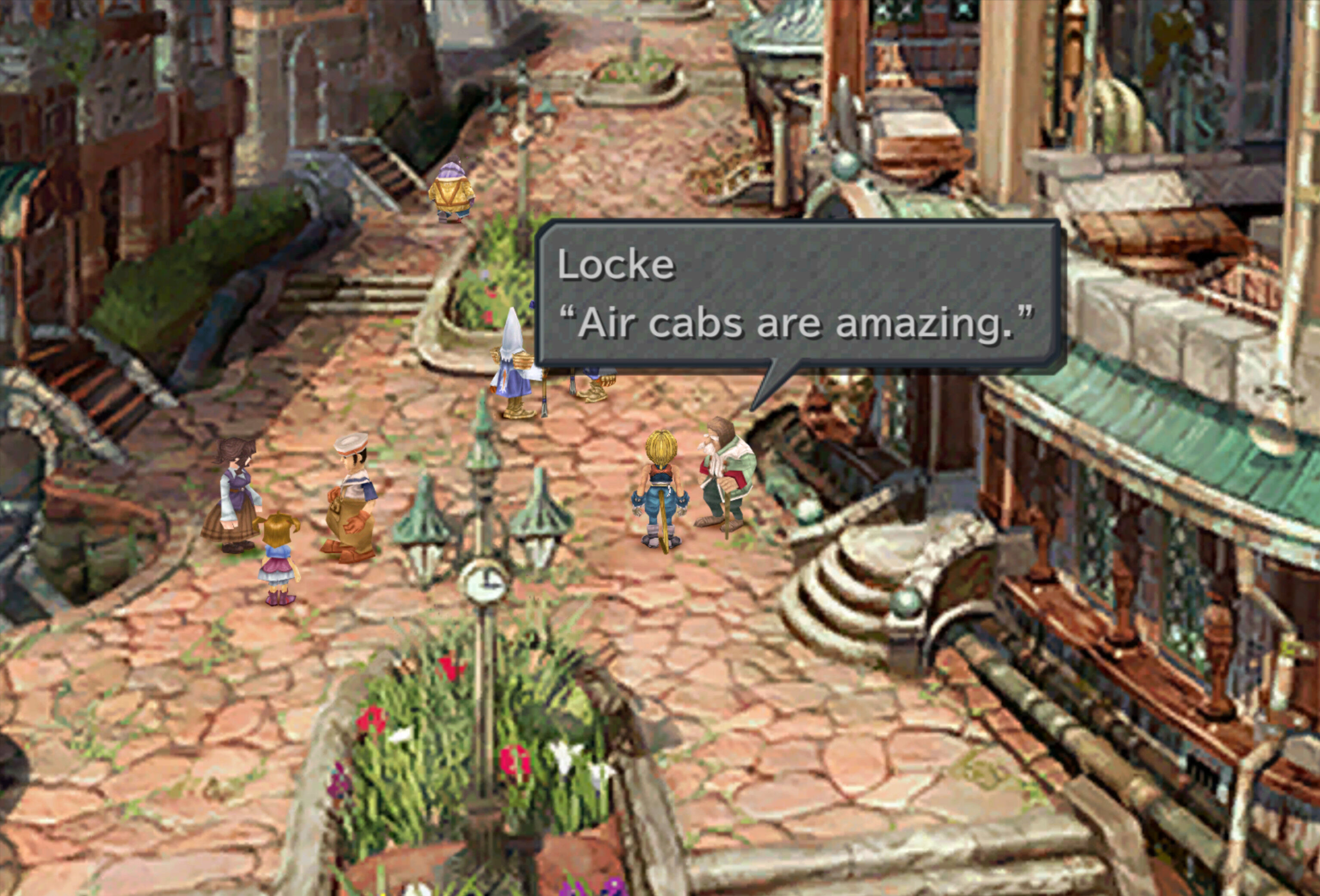

- Trance first appeared in Final Fantasy VI as Terra's skill after she unlocks her esper powers. When in Trance, Terra would turn pink and be more powerful than normal, the same which happens in Final Fantasy IX. Trance was translated as "Morph" in the Final Fantasy VI English version.
- The eidolon Madeen is misromanized; it was meant to invoke the name of Maduin from Final Fantasy VI (which, in the original Japanese versions of both games, was written as (マディーン, Madīn?)). Incidentally, the slightly-nonsensical name of its attack, "Terra Homing", was intended to be "Terraforming". In juxtaposition, however, while Maduin from Final Fantasy VI is male, Madeen from Final Fantasy IX is female.
- In Lindblum, the characters may encounter an old man named Locke, possibly a reference to Locke Cole.
- The way Kuja throws Garland off Pandemonium is reminiscent of the way Kefka throws Emperor Gestahl off the Floating Continent.
- Beatrix has many thematic similarities to General Leo, both being generals for the games' initial antagonists, who find themselves sympathizing with the protagonists.
- Both Beatrix and General Leo have access to an attack called Shock. Steiner can also use it.
- Mog is the name of Eiko's moogle friend, as well as the moogle who joins the party in Final Fantasy VI. In juxtaposition, however, the Mog of Final Fantasy IX is female.
- The floating eyeball monster, commonly known as Ahriman in the more recent games, was changed back to "Veteran", its Final Fantasy VI name.
- Flare Star, an attack used by Ozma and Trance Kuja, originates from Final Fantasy VI as one of the Atma Weapon's attacks.
- Many magic-based enemies in Final Fantasy VI can be defeated by draining their MP through Rasp or Osmose. The enemy Valia Pira in Final Fantasy IX can also be defeated in this manner via Quina's Magic Hammer.
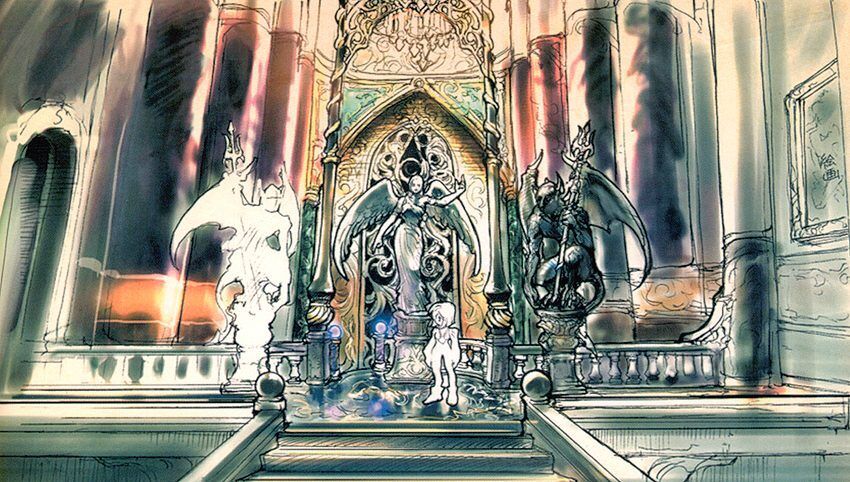
- The Desert Palace contains many works of art, including a trio of statues arranged in a triangular fashion. Two are decidedly demonic-looking, replete with bat-like wings and tridents, and are referred to as the "Promise of the Evil God" and "Truth of the Devil". The white angelic statue in the middle is called the "Illusion of the Goddess". This alludes to the Warring Triad from Final Fantasy VI.
- The area around the Chocobo's Forest is called the "King Ed Plains" in the menu, referring to Edgar Roni Figaro, who is the king of Figaro.
- Treno has numerous similarities with Jidoor and Zozo that consists of Jidoor's lower-class. The Treno wealthy live by the waterfront, while the poor live in the hills, paralleling Jidoor, which is by the ocean, and Zozo, which is in the mountains. Both Treno and Jidoor have an auction house. Treno is home to many thieves, like Zozo, which is populated almost entirely of thieves.
- Like Zozo, Burmecia is a ruined, constantly rainy city which at one point requires the player to jump from one building ledge to another to proceed. Both towns also have thief-like enemies who can steal from the party.
- The town of Alexandria has a statue commemorating a General Madelene. In Final Fantasy VI, Madeline was the name of Terra Branford's mother.
- Eidolons are learned by Dagger and Eiko through gemstones much in the same manner espers are learned via magicite. The correlation is shown when the twin jesters Zorn and Thorn extract the eidolons from Dagger trapping them in a gemstone form.
- The eidolon Carbuncle has different effects depending on what gemstone Eiko has equipped. The effects Carbuncle can grant the party (minus Vanish) are learnable from the esper Carbuncle in Final Fantasy VI.
- In Disc 2, after the destruction of Lindblum, talking to an Alexandrian soldier will reveal Brahne had plans to build an Opera House in the Theater District.
- Final Fantasy VI and Final Fantasy IX share a plot point of kidnapping a female protagonist via a theatrical production. In Final Fantasy VI, Celes Chere is to be kidnapped by Setzer Gabbiani via an airship during the opera Maria and Draco. In Final Fantasy IX, Tantalus Theater Troupe plans to kidnap Princess Garnet onto their theater ship during their performance of I Want To Be Your Canary.
- Like Kefka, Kuja plans to overthrow his boss, Gestahl and Garland respectively, using the power of the games' respective summons. While Garland is Kuja's literal creator, in Final Fantasy VI, Gestahl's role can be seen as similar, as it was the Empire's making of Kefka into a Magitek Knight that granted him his powers.
Final Fantasy VII
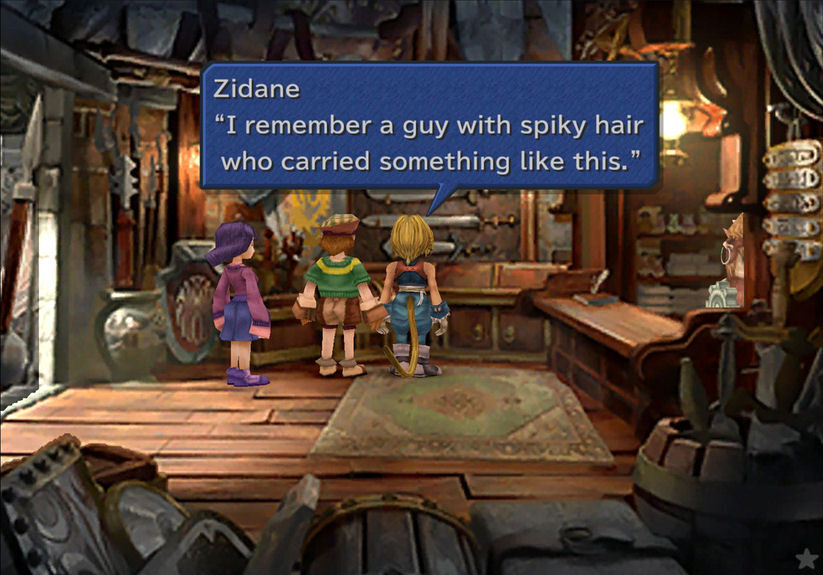

- After the M.S. Prima Vista crashes into the Evil Forest, Tantalus's band plays "Rufus' Welcoming March" in an Active-Time Event, which plays in the background in the city of Junon in Final Fantasy VII.
- On the left side of the room inside the inn located in Dali, a device will read the player's fortune and give their lucky color of the day. This is reminiscent of the first encounter Cait Sith has with the traveling party in Gold Saucer, where he keeps messing up the player's fortune. Gold Saucer also has a fortune-telling device in the Wonder Square.
- If the player examines a large sword in the Lindblum weapon shop, Zidane will say, "I remember a guy with spiky hair who carried something like this", a reference to Cloud Strife, the protagonist of Final Fantasy VII, who carried a large sword named the Buster Sword.
- There is a little girl in Lindblum named Elena.
- During Disc 3, Alexandria is in ruins. In front of the steeple on the edge of town, a woman bearing the title of "Flower Girl" says, "He's handsome, but he's not exactly Mr. Personality..". in reference to Weimar, Pluto Knight VII. This may be an allusion to Final Fantasy VII where Aerith Gainsborough was known as the flower girl and the protagonist Cloud Strife has a cold personality at the start of the game.
- Zidane and Cloud experience a similar identity crisis: Zidane learns he is a Genome created for reaping the souls of Gaia, causing him to lose himself before his friends intervene and snap him out of it; in Final Fantasy VII, Cloud is momentarily made to believe he is an artificially created Sephiroth-clone and needs Tifa's help to come to his senses.
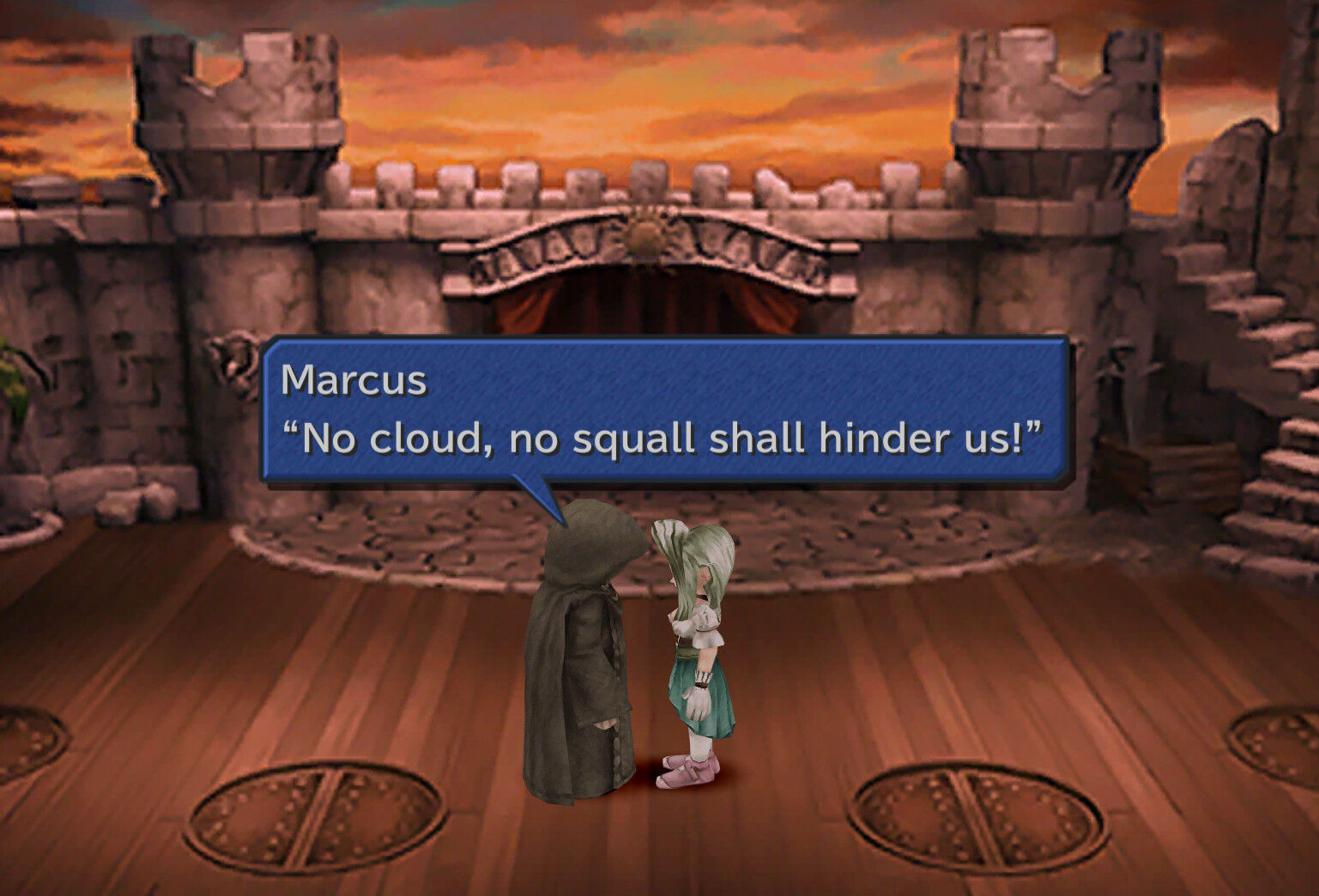
- During the play in Final Fantasy IX's ending, Marcus says, "No cloud, no squall shall hinder us!", referring to Cloud Strife of Final Fantasy VII and Squall Leonhart of Final Fantasy VIII. This allusion is only in the English version, the original Japanese being「もちろんだ、たとえ雨が降っても嵐が来ても!, which translates to "Of course, not even rain or a storm can stop us!".
- Steiner and Beatrix both have an ability called Climhazzard, one of Cloud's second level Limit Breaks.
- Zidane's skill Lucky Seven likely alludes to the All Lucky 7s status from Final Fantasy VII, as it involves Zidane's HP ending in the number 7 to inflict a random 7, 77, 777 or 7777 damage. In Final Fantasy VII, All Lucky Sevens made a unit with 7777 HP always inflict 7777 damage/heal with their actions.
- Hades, a summon in Final Fantasy VII, appears as an optional boss in Final Fantasy IX.
- Chocobo footprints on the world map are the only place one can encounter chocobos (as a random encounter and with normal enemies) in Final Fantasy VII; chocobo footprints in Final Fantasy IX serve a similar function, allowing the player to call Choco via a Gysahl Green.
- The chocobos' default name is "Choco" in Final Fantasy VII. This is the name the player's chocobo is called in Final Fantasy IX.
- In the minigame "Mog's House" in Final Fantasy VII, the moogle's favorite food is Kupo Nuts. In Final Fantasy IX, Kupo Nuts remain a moogle's favorite food and can be given to a moogle in Gizamaluke's Grotto.
- Both the Gaia of Final Fantasy IX and the Gaia of Final Fantasy VII display similar foundational life-cycle structure and, thus, primary character conflicts and motives:
- In Final Fantasy VII, all life consists of Mako; when a lifeform dies, its energy returns to the Lifestream where it is recycled and born again elsewhere. In Final Fantasy IX, every life possesses a soul; when a lifeform dies, its soul attempts to return to the planet's Crystal, which creates all the life on the planet. In both games, this flow of life is tampered with by the games' antagonists.
Final Fantasy VIII
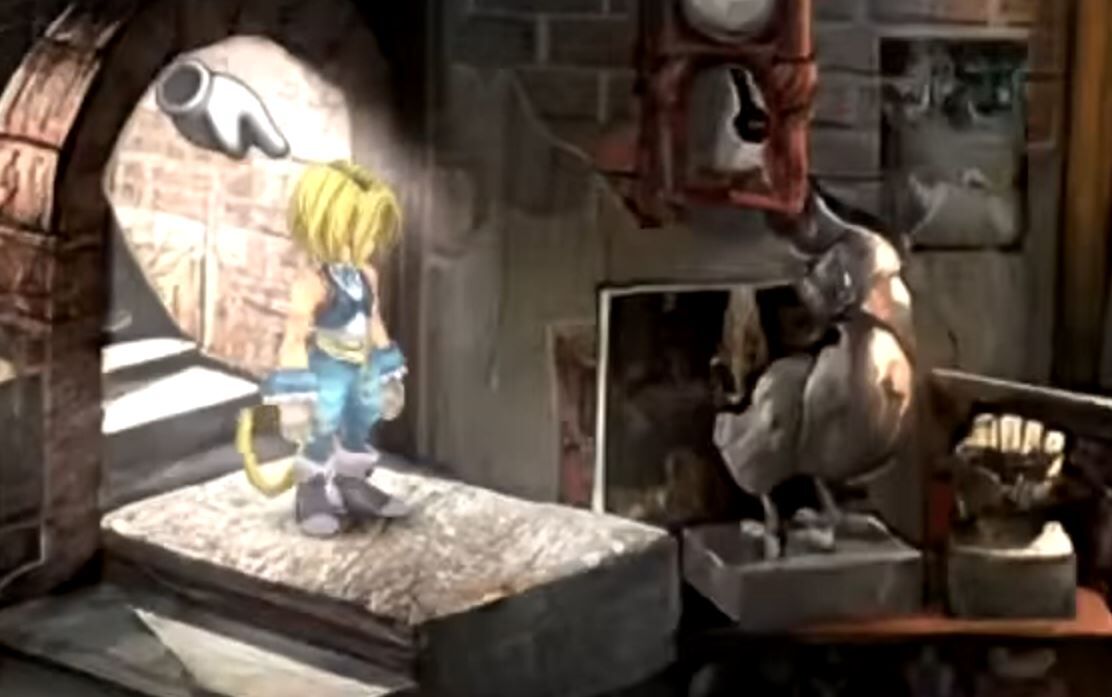

- Squall is mentioned in the game's ending. (See above section.)
- Amarant's No Mercy ability is a reference to Seifer's Limit Break attack of the same name. Both involve a large ball of energy to be formed by the user.
- Freya's White Draw ability is somewhat reminiscent of the Draw ability in that both take MP/magic from the enemy to replenish the user's MP/magic stock.
- The fine artist Michael in Lindblum's Theater District has a sculpture in his studio of a chocobo that bears no resemblance to the chocobo models used in Final Fantasy IX: it is the chicobo model used in the Final Fantasy VIII Chocobo Hide & Seek minigame.
- The air cabs used to ferry people between Districts in Lindblum have "08" written on them, as do the buses in Deling City.
- The theme that plays while fighting Trance Kuja, "Dark Messenger", shares its name with Diablos's summon attack.
- A map depicting Planet Earth's topography hangs on the back wall of the Prima Vista's huddle room. Final Fantasy VIII is the only other title in the series to show a map of Planet Earth, which hangs on the stairwell wall of the Flower Restaurant in Winhill. In both titles they are witty set dressing: wall decor of nonexistent "fantasy" worlds.
Final Fantasy X

Final Fantasy IX is the first game in the series to make an allusion to a future Final Fantasy game.
- The card Ragtime Mouse is holding has a message presented on the face of the card most players will never see. The text is in Japanese and reads: "It's a 'true or false' quiz. FF10's theme is GUTS! True or false?"
Final Fantasy Tactics
- In Final Fantasy IX, Garnet is an orphan who was adopted and raised as royalty due to the real princess having died young. The same fate befalls Princess Ovelia of Final Fantasy Tactics.
- A large number of equipment names and abilities are taken from Final Fantasy Tactics.
- Many of Steiner's sword skills are named from Final Fantasy Tactics.
- Before Final Fantasy IX, perfumes or fragrances were only equippable in Final Fantasy Tactics. They can only be equipped by females as well. The rouge was retroactively introduced into Final Fantasy Tactics: The War of the Lions.
- The game-long sidequest involving the Stellazzio coins uses the twelve signs of the zodiac; though a common reference in the role-playing genre, this may be a nod toward Final Fantasy Tactics. Both games have a secret 13th zodiac sign in the form of Ophiuchus coin in Final Fantasy IX and the Serpentarius Stone in Final Fantasy Tactics.
- Freya's ability, Reis's Wind, is named after Reis Duelar.
- Another of Freya's abilities, Cherry Blossom, is Cloud Strife's eighth Limit in Final Fantasy Tactics.
- Beatrix's sword, Save the Queen, first appeared in Final Fantasy Tactics as the weapon of Meliadoul Tengille when she joins the player's party.
Allusions to the number nine
Being the ninth installment of the series, Final Fantasy IX makes some references to the number itself. Although these are not necessarily deliberate allusions to the number 9 (whether they are or not is speculative), they are nonetheless present.
- There are nine active members in the Knights of Pluto. At the time of the game's release, Pluto was considered to be the ninth planet of the Solar System.
- There are numerous boats, airships, and war machines in the game, but only nine carry names: the Prima Vista, the Cargo Ship, the Blue Narciss, the Viltgance, the Hilda Garde Marks I, II, and III, the Red Rose, and the Invincible.
- Regent Cid Fabool IX is the ninth Cid in Lindblum's lineage. This may also be a reference to each prior Final Fantasy game having included a character called Cid (including the unseen one from the original game).
- His predecessor and father, Cid VIII, developed the first Mist-powered airships in 1762, led the Lindblum armada in 1771, and died in 1780; each event has a span of nine years between them.
- Aside from the Cid IX, the two most referred to of his predecessors in the game are Cid VIII and Cid I. (1 + 8 = 9).
- The Prima Vista theater ship weighs 8,235 tons and has a guest capacity of 288 passengers. Both figures are multiples of 9.
- In the track "Ambush Attack", Nobuo Uematsu pulls off an obscure, rarely-used 9/4 time signature in the piece's opening measures before switching to 4/4.
- If one counts Alexander, Dagger has access to nine eidolons. Even without Alexander, the Odin's Sword ability grants Dagger nine eidolon attacks.
- While Eiko only has access to four eidolons, she has nine types of eidolon attacks.
- An aforementioned Final Fantasy Tactics allusion refers to Worker #9.
- One of Zidane's Dyne abilities is called Solution 9.
- Although Vivi was born six months prior to the game's events, with references citing he was "born" in 1799,[1] his age is listed as 9 years old in the game's manual.
- Zidane's birthday is in September, the ninth month of the year.
- Mikoto is 9 months old.[1]
- Garnet's coronation was supposed to happen on February 9.
- The Heroine Statue near the entry gate of Alexandria commemorates the valiant General Madelene, who, at 13 in 1389, fought in the Lindblum Army in the 9th Lindblum War with a mere nine soldiers under her command.
- There are nine different thief swords and staves.
- Altogether, there are nine friendly monsters in the game-long side quest to limit Ozma's powers. 9 Ores are required to appease the first five monsters in the quest.
- One of the first field treasures the player can find is 9 Gil of "grandma's savings" from a residence in Alexandria.
- A Fabool Publications article pinned to the wall in Card Freak Gon's house in Lindblum is written by Card Collector No. 9.
- Before Zidane and Garnet wed in Conde Petie to pass to the Iifa Tree, 99 other couples had gone through the ritual before them.
- To reveal Garnet's true name on the Eidolon Wall in Madain Sari, the player must circle through the area nine times. On the ninth round, HP and MP will be recovered and all status abnormalities removed.
- To complete the Lost Family Sidequest, the player must complete nine different advancement points.
- There are 9 boss fights in the final dungeon, namely Nova Dragon, Maliris, Tiamat, Hades, Kraken, Lich, Deathguise, Trance Kuja, and Necron.
Other Square projects
Chocobo no Fushigina Dungeon
- One of the Mognet moogles is named after Poulet's friend moogle, Atla.
Chrono Trigger
- When Cid Fabool IX is transformed from an oglop into a frog, his frog form resembles the character Frog from Chrono Trigger.
- The Frog Drop ability takes its name and design from the Chrono Trigger tech Frog Squash; both are written identically in Japanese. The ability in Chrono Trigger also involved summoning a giant frog to land on the enemies. In addition, the appearance of the summoned frog is similar to Frog from Chrono Trigger.
Chrono Cross
- The weapon type of thief swords appears to be inspired and visually similar to the Sea Swallow weapons wielded by the main character Serge. Both Serge and Zidane wield a unique manifestation of the Masamune weapon in their respective games. Chrono Cross was released around the same period of time and console era Final Fantasy IX was in.
Cruise Chaser Blassty
- The eidolon Ark's design is a nod to the 1986 Square sci-fi Mecha RPG Cruise Chaser Blassty, influenced by the mecha SPEX-07 Blassty.
Vagrant Story
- The barkeep and later mini-theater owner in Alexandria shares the same name and hair style as Ashley Riot, the protagonist of Vagrant Story.
Parasite Eve
- The two owners of the synthesis shop in Lindblum are called Torres and Wayne. In Parasite Eve, Torres dies, but in Final Fantasy IX, Torres is merely badly injured after Alexandria attacks Lindblum. The two also have an argument, which is practically the same as the "Safety vs. Power" lecture overheard when first entering the NYPD weapons room in Parasite Eve.
Non-Square related
Other games
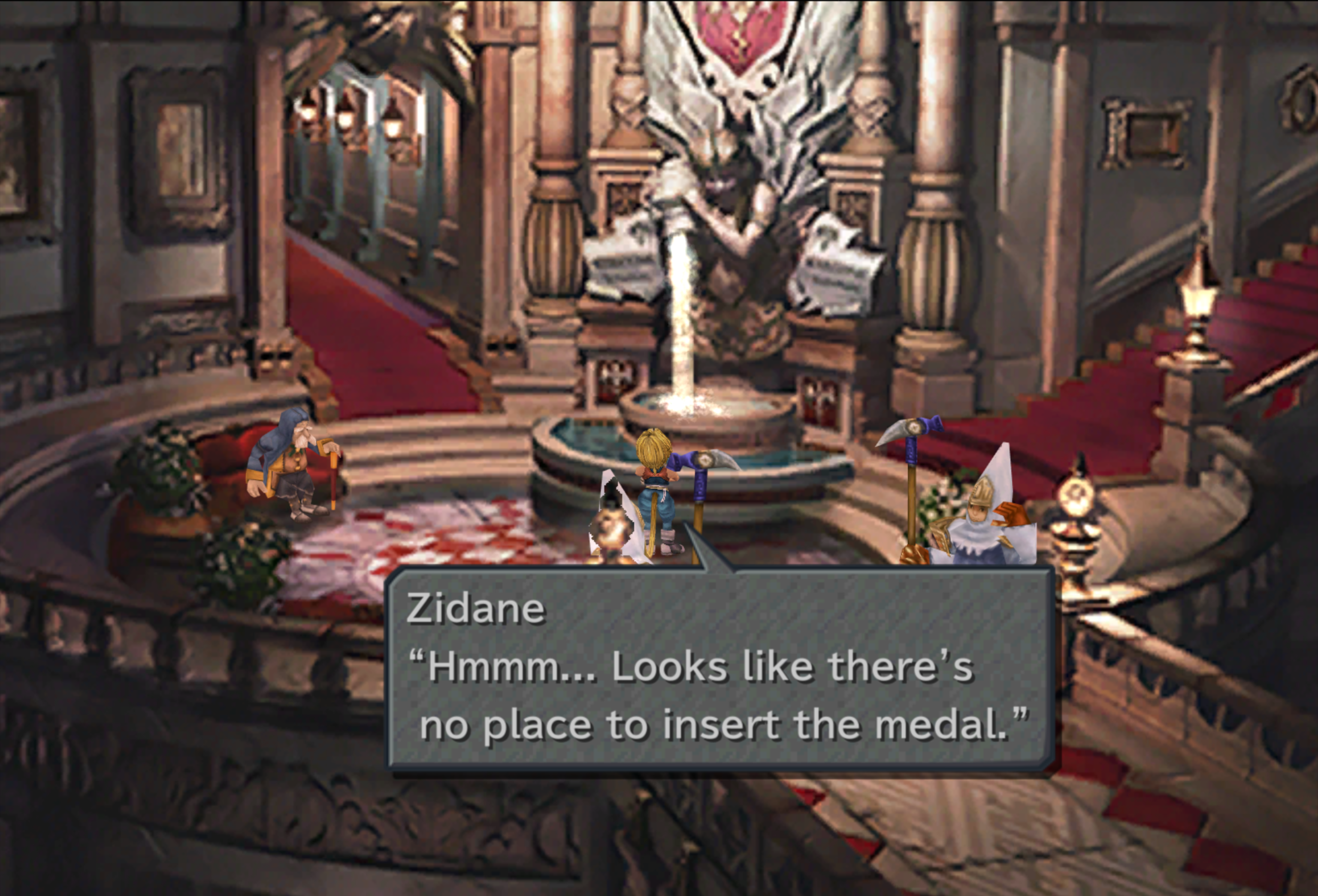
- Upon inspecting the fountain within Lindblum Castle, the flavor text reads ...Looks like there's no place to put the medal here. Since there are no puzzles, plot points, or anything else in the game related to this fountain, it can be assumed that this is an allusion to the Capcom game Resident Evil 2.
- According to a PlayStation Magazine interview with localization director Brody Phillips (now working with Sega): In the opening sequence of Alexandria, Puck says to himself, Engage according to mission parameters! This is a reference to the PC Game, Unreal Tournament.
- When the party visits Treno for the first time, there is an Active Time Event where Marcus passes two children: the big sister Giana and the little Mario. These may be a reference to the games Giana Sisters and Super Mario.
Movies & television
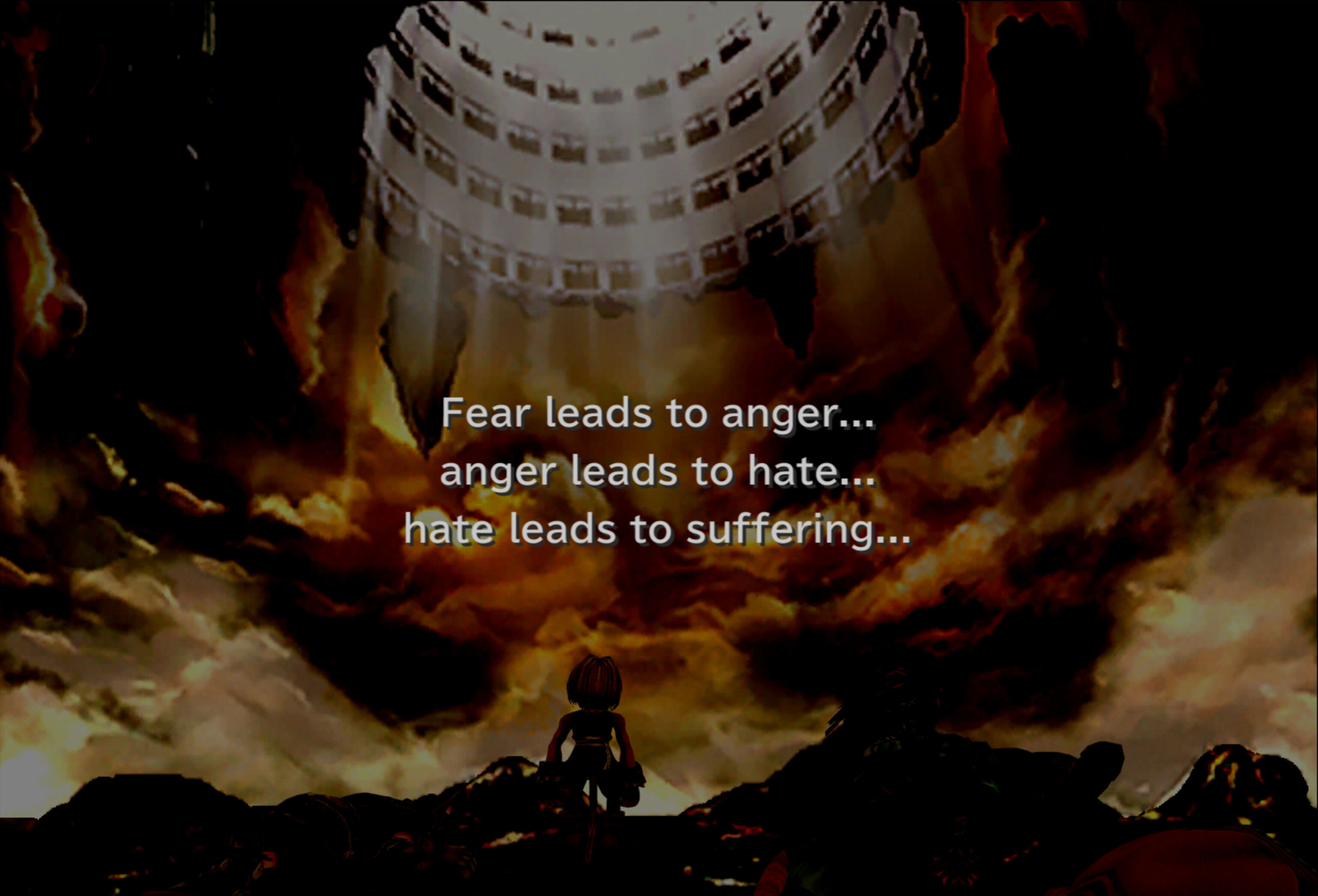
- In Lindblum, a man near the air cab station will say, "Dammit Jim, I'm a doctor, not a miracle worker!", a quote from Star Trek. Before fighting Black Waltz 2, he says "Resistance is futile", a reference to the Borg.
- Necron's line in the English localization, "Fear leads to anger. Anger leads to hate. Hate leads to suffering", originally belonged to Yoda in Star Wars: Episode I The Phantom Menace. Additionally, Kuja's line "Everything is proceeding as I have foreseen" was used by Palpatine (Darth Sidious) in Star Wars: Episode VI Return of the Jedi.
- After fighting Steiner at the beginning of the game, he says, "Bah! Only a flesh wound", a reference to a line of Monty Python and the Holy Grail's Black Knight.
- Similarly, one of the few things Zorn and Thorn say in unison is, "Run away!"
- Ruby refers to Blank and Marcus as "those good ol' boys". Considering Ruby's Southern belle persona, this is likely a reference to The Dukes of Hazzard.
- After receiving a Kupo Nut, one moogle remarks that he's "Kupo for Kupo Nuts", a parody of the Cocoa Puffs commercial, in which the mascot Sonny the Cuckoo Bird states that he is "Cuckoo for Cocoa Puffs".
- During the Festival of the Hunt, a man being chased by a Mu screams "Great Scott!", a reference to the Back to the Future trilogy's Doc Brown, who shouts it multiple times throughout the films in the face of astounding or bewildering occurrences.
- Likely to keep in theme with the throwback nature of Final Fantasy IX, much of its art direction takes on movie-prop-like dynamics, and uses dynamic celestial object-based lighting in its backgrounds and cinematics. While such design elements are common in fantasy video game design, its otherworldly feel, along with its medieval steampunk fantasy setting, may tie back into the late 1980s, where Final Fantasy originates. In the 1980s, the fantasy genre within theatrical big budget Hollywood movies had undergone a windfall of releases, including movies such as the Dark Crystal, Labyrinth, Legend, and the Conan the Barbarian series, and were also famous in Japan.
Anime & manga
- The appearance of the inhabitants of Terra, including the "Angels" Zidane and Kuja, and their traits of planetary invasion to propagate and continue their dominance and well-being throughout the universe, resemble the powerful and space-traveling ravaging warrior Saiyan race of the martial arts fantasy series Dragon Ball Z.
- The backstory of Zidane resembles the story of Son Goku. Both are monkey-like aliens sent to the planet to destroy and conquer it. Both end up suffering from amnesia and fighting to protect the planet instead.
- Zidane and Kuja's ability of Trance, though not unique to them, grants them appearances and abilities reminiscent to that of the legendary Super Saiyan and Great Ape forms of the Saiyan race.
- Both Dragon Ball Z and Final Fantasy IX may be using Journey to the West as inspiration, one of the Four Great Classical Novels of Chinese literature attributed to Wu Cheng'en. Popular and story-teller versions of Xuanzang's journey dating as far back as the Southern Song dynasty include a monkey character as a protagonist.
Literature and theater
- There are numerous Shakespearean allusions in Final Fantasy IX.
- Puck is named after a character in William Shakespeare's play A Midsummer Night's Dream that was based on the ancient figure in English mythology, also called Puck. He is a mischievous elf or sprite that personifies the trickster or the wise knave in the aforementioned play.
- The play I Want to Be Your Canary is similar to William Shakespeare's King Lear and Romeo and Juliet, with the hero, Marcus, in love with Cornelia, the daughter of his enemy, King Leo. Leo wishes Cornelia to marry Prince Schneider, a man she does not love. Both Cornelia and Marcus end up dying for their love.
- In the original Japanese, the King in I Want to Be Your Canary played by Baku is King Lear, a reference to Shakespeare's character.
- I Want to Be Your Canary has a princess called Cornelia, which likely refers to King Lear as well, although it may also reference the location from the original Final Fantasy.
- The author of I Want to Be Your Canary is Lord Avon, referring to Shakespeare who was referred to as the "Bard of Avon".
- Like the plays in Shakespeare's time, plays were performed for both royalty and commoners. In Final Fantasy IX, the audience includes Queen Brahne, nobles, and common folk like Vivi on the rooftops.
- Two enemies fought in the game—Jabberwock and Bandersnatch—are creatures from Lewis Carroll's famous poem Jabberwocky. These names were also used for two bosses in Final Fantasy XIII.
- The Knights of Pluto's name could be a play on The Raven, a poem by Edgar Allan Poe, as the titular raven arrives on the narrator's doorstep from "Night's Plutonian shore".
- Ipsen's Castle is potentially a reference to the Norwegian playwright Henrik Ibsen.
Music
- In musical notation, to perform a piece a prima vista means to read and play written music the performer has not seen before, literally "at first sight". The Theater Ship's name is Prima Vista and appears right in the opening, perhaps alluding to this concept.
- A set of achievements on the Steam version of Final Fantasy IX, awarded for killing certain numbers of enemies, is called "Let the Bodies Hit the Floor". This alludes to the 2001 single Bodies by Drowning Pool.
Cultural
- The game details a strained romance between part-time worker Mary, owner of the Vega Shop in the northern station of South Gate, and Jobless Jeff, operator of the Altair Shop in the southern station, which mirrors the real-life Tanabata legend.
- The ceremony for the magical sandstorm that protects Cleyra is a homage to traditional Irish dance. Additionally, Fratley's name is based on the name of Michael Flatley, a world-famous Irish dancer.
- Madain Sari is named after a pre-Islamic archaeological site in Saudi Arabia called Mada'in Saleh. In the Qur'an, the people of Mada'in Saleh, the tribe of Thamud, or the Thamudis, fell to the worshiping of idols. The word "eidolon" in Final Fantasy IX is related to the word "idol" and Madain Sari was the center for summoning arts.

- The symbol of the planet of Terra is the symbol of the "triforce" (three isosceles triangles joined at the corners to make one, larger triangle with its center missing). The pattern is most prominently featured in Oeilvert. The shape is a common pattern that has been used in Japanese embroidery, clothing design, and architecture for centuries, though arguably it is most famous for appearing in all of the Legend of Zelda games.
- The Festival of the Hunt may have been inspired by the Running of the Bulls practiced mainly in Spain and Portugal, which involves letting loose bulls on a course of a sectioned-off subset of a town's streets, and participants have to run in front of them. Unlike bullfights, which are performed by professionals, anyone may participate in the Running of the Bulls.
- Ash's design is based on Baphomet, an imagined pagan deity, product of Christian folklore concerning pagans. The similarities between Ash and Baphomet notwithstanding, its hand gestures resemble both The Magician and The Devil Tarot cards. In all these aspects, Baphomet represents the binary nature of all things and the total sum of the universe: male and female, past and present, good and evil, and in this interpretation, Gaia and Terra.
- The eidolon Ark's origins coming from invaders from another world, being an airship, and its Dark-elemental affinity, may be a throwback to the Japanese late Edo Period-born concept of the black ships. The fact that it is a robot, but described as "the beast from the dark", is also a wordplay on the suffix counter word -goki, where it is used to count machinery, but can also mean "strong demon" by homophony.
- The jewels are based on birthstones. If the player has all twelve jewels in their inventory (minus Ore), they are listed in the same order as the birthstones where each gemstone represents a month.
- Emphasizing the tree's association with life, the circle-and-cross pattern on the front of the Iifa Tree resembles the Ankh, an Ancient Egyptian symbol for life. The tree of life is a common motif in many mythologies.
Real-world people
- The statue commemorating General Madelene in Alexandria is likely a reference to the young French patron saint Joan of Arc.
- There is an air cab engineer in Lindblum by the name of Nimitz who says he nearly lost his arm during construction. Chester W. Nimitz was a fleet admiral for the United States Navy who lost part of his finger in an accident involving a diesel engine.
Others
- When Steiner witnesses the barrels with the Alexandria crest being loaded in Dali village, he pokes one barrel with his sword, and Zidane, a thief who lives on an airship, pops out—a reference to the popular Kurohige pirate-in-a-barrel game.
- Tantalus is the name of a large volcanic crater in the Koʻolau Range overlooking Honolulu, Hawaii, where much of Final Fantasy IX was developed[2] at the now-defunct Square USA branch. Final Fantasy IX is sprinkled with references to Hawaii, both subtle and not-so-subtle, such as the Southern Tropical Outfits set.
- It is also the name of the villain in a Greek legend, who was doomed to stand in the Underworld beneath a tree of succulent fruit he could not reach and surrounded by crystalline water he could not drink—the word "tantalize" derives from it.
